A New GIS-Based Algorithm to Support Initial Transmitter Layout Design in Open-Pit Mines
Abstract
:1. Introduction
2. Principles of the Fresnel Zone and the 3D Fresnel Index
3. Algorithm Development
3.1. Selecting Multiple Candidate Locations of Transmitters
3.2. Calculating the 3D Fresnel Index
3.3. Analyzing Favorable Transmitter Combinations
4. Application
4.1. Study Area and Data
4.2. Result of Selecting Transmitter Candidates
4.3. Result of Generating 3D Fresnel Index Maps
4.4. Result of Analyzing the Favorable Transmitter Combinations
5. Discussion
5.1. Comparison with Existing Algorithms Based on LOS and 2D Partial Fresnel Zone Analyses
5.2. Site Acceptance Test
6. Conclusions
Author Contributions
Funding
Acknowledgments
Conflicts of Interest
References
- Durrant-Whyte, H.; Geraghty, R.; Pujol, F.; Sellschop, R. Mining’s Next Performance Horizon: Capturing Productivity Gains from Innovation. Available online: https://www.mckinsey.com/~/media/mckinsey/dotcom/client_service/metals%20and%20mining/pdfs/minings_next_performance_horizon.ashx (accessed on 30 May 2018).
- Baek, J.; Choi, Y.; Park, H. Uncertainty Representation Method for Open Pit Optimization Results Due to Variation in Mineral Prices. Minerals 2016, 6, 17. [Google Scholar] [CrossRef]
- Baek, J.; Choi, Y. A New Method for Haul Road Design in Open-pit Mines to Support Efficient Truck Haulage Operations. Appl. Sci. 2017, 7, 747. [Google Scholar] [CrossRef]
- Baek, J.; Choi, Y.; Lee, C.; Suh, J.; Lee, S. BBUNS: Bluetooth Beacon-Based Underground Navigation System to Support Mine Haulage Operations. Minerals 2017, 7, 228. [Google Scholar] [CrossRef]
- World Economic Forum. Digital Transformation Initiative Mining and Metals Industry. Available online: http://reports.weforum.org/digital-transformation/wp-content/blogs.dir/94/mp/files/pages/files/wef-dti-mining-and-metals-white-paper.pdf (accessed on 30 May 2018).
- Modular Mining Systems’ DISPATCH. Available online: http://www.modularmining.com/product/dispatch-underground/ (accessed on 30 May 2018).
- Hexagon Mining’s Jtruck. Available online: http://hexagonmining.com/products/all-products/jtruck/ (accessed on 30 May 2018).
- Mine Site Technologies’ Asset Tracking System. Available online: http://mstglobal.com/solutions/asset-people-tracking/underground-hard-rock/ (accessed on 30 May 2018).
- MISOM Technologies’ FARA (Field Analysis & Reporting Application). Available online: http://misom.com/applications/fara/ (accessed on 30 May 2018).
- Minlog’s MineSuite Fleet Management System. Available online: http://www.minlog.com/minesuite/ (accessed on 01 November 2018).
- Hexagon Mining’s Jigsaw Operations Suite. Available online: http://hexagonmining.com/products/ operations-suite/fleet-management/ (accessed on 30 May 2018).
- Caterpillar’s MineStar. Available online: http://www.cat.com/en_US/campaigns/awareness/cat-minestar-command.html/ (accessed on 30 May 2018).
- GE mining’s Digital Mine: Safety Solutions. Available online: https://www.ge.com/digital/products/digital-mine-safety-solutions (accessed on 30 May 2018).
- Modular Mining Systems’ MineAlertTM. Available online: http://www.modularmining.com/product/minealert/ (accessed on 30 May 2018).
- Mine Site Technologies’ IMPACT Proximity Awareness. Available online: http://mstglobal.com/solutions/proximity-detection/surface-mining/ (accessed on 30 May 2018).
- Strata’s Hazardavert®. Available online: https://www.strataworldwide.com/proximity-detection (accessed on 30 May 2018).
- Mine Site Technologies’ FARA (Field Analysis and Reporting Application). Available online: http://mstglobal.com/solutions/productivity/fara-underground-and-surface-mining/ (accessed on 30 May 2018).
- Modular Mining Systems’ ProVision Machine Guidance System. Available online: http://www.modularmining.com/product/provision/#tab-0 (accessed on 30 May 2018).
- Modular Mining Systems’ AHS (Autonomous Haulage System). Available online: http://www.modularmining.com/solution/autonomous-haulage/#tab-0 (accessed on 30 May 2018).
- Modular Mining Systems’ RemoteCareTM. Available online: http://www.modularmining.com/product/minecare-3/#tab-4 (accessed on 30 May 2018).
- Vellingiri, S.; Tandur, D.; Kande, M. Energy Efficient Wireless Infrastructure Solution for Open Pit Mine. In Proceedings of the 2013 Advances in Computing, Communications and Informatics (ICACCI), Mysore, India, 22–25 August 2013; IEEE: New York, NY, USA, 2013; pp. 1463–1467. [Google Scholar]
- Kennedy, B.A. Surface Mining, 2nd ed.; Society for Mining, Metallurgy and Exploration (SME): Littleton, CA, USA, 1990; ISBN 9780873351027. [Google Scholar]
- Darling, P. SME Mining Engineering Handbook, 3rd ed.; Society for Mining, Metallurgy and Exploration (SME): Littleton, CA, USA, 2011; pp. 1–1840. ISBN 9780873352642. [Google Scholar]
- Aitken, J.J. Development of a Radio Propagaion Model for an Open Cut Mine. In Proceedings of the 20th International Electronics Convention & Exhibition (IREECON ’85), Melbourne, Australia, 30 September–4 October 1985; pp. 639–641. [Google Scholar]
- Almeida, E.P.L.; Caldwell, G.; Rodriguez, I.; Abreu, S.; Vieira, R.D.; Barbosa, V.S.B.; Sprensen, T.B.; Mogensen, P.; Garcia, L.G.U. Radio Propagation in Open-pit Mines: A First Look at Measurements in the 2.6 GHz band. In Proceedings of the 2017 IEEE 28th Annual International Symposium on Personal, Indoor, and Mobile Radio Communications (PIMRC), Montreal, QC, Canada, 8–13 October 2017; IEEE: New York, NY, USA, 2017; pp. 1–6. [Google Scholar]
- Almeida, E.P.L.; Caldwell, G.; Rodriguez, I.; Vieira, R.D.; Soerensen, T.B.; Mogensen, P.; Garcia, L.G.U. 5G in Open-Pit Mines: Considerations on Large-Scale Propagation in Sub-6 GHz Bands. In Proceedings of the 2017 IEEE Globecom Workshops (GC Wkshps), Marina Bay Sands Expo and Convention Centre, Singapore, 4–8 December 2017; IEEE: New York, NY, USA, 2017; pp. 1–6. [Google Scholar]
- Almeida, E.P.L.; Caldwell, G.; Rodriguez, I.; Vieira, R.D.; Sorensen, T.B.; Mogensen, P.; Garcia, L.G.U. An Empirical Study of Propagation Models for Wireless Communications in Open-pit Mines. In Proceedings of the 2018 IEEE 88th Vehicle Technology Conference (VTC2018), Chicago, IL, USA, 27–30 August 2018; IEEE: New York, NY, USA, 2018; pp. 1–6. [Google Scholar]
- Modular Mining Systems’ Masterlink®. Available online: http://www.modularmining.com/wp-content/uploads/MasterLink-Enterprise-Flyer-English.pdf (accessed on 30 May 2018).
- Mine Site Technologies’ IMPACT® WSN Wireless Sensor Network. Available online: http://mstglobal.com/?resources=wsn-wireless-sensor-network (accessed on 30 May 2018).
- Sherali, H.D.; Pendyala, C.M.; Rappaport, T.S. Optimal location of transmitters for micro-cellular radio communication system design. IEEE J. Sel. Areas Commun. 1996, 14, 662–673. [Google Scholar] [CrossRef]
- Jaber, M.; Dawy, Z.; Akl, N.; Yaacoub, E. Tutorial on LTE/LTE-A Cellular Network Dimensioning Using Iterative Statistical Analysis. IEEE Commun. Surv. Tutor. 2016, 18, 1355–1383. [Google Scholar] [CrossRef]
- Puspitasari, N.F.; Al Fatta, H.; Wibowo, F.W. Layout Optimization of Wireless Access Point Placement Using Greedy and Simulated Annealing Algorithms. Network 2016, 2. [Google Scholar] [CrossRef]
- Freeman, R.L. Fundamentals of Telecommunications, 2nd ed.; John Wiley & Sons: Hoboken, NJ, USA, 2005; pp. 1–720. ISBN 9780471720935. [Google Scholar]
- Parsons, J.D. The Mobile Radio Propagation Channel, 2nd ed.; John Wiley & Sons: Chichester, UK, 2000; pp. 1–401. ISBN 978-0-471-98857-1. [Google Scholar]
- Campbell Scientific, Inc. Line of Sight Obstruction. Available online: https://s.campbellsci.com/documents/us/technical-papers/line-of-sight-obstruction.pdf (accessed on 23 May 2018).
- Coleman, D.D.; Westcott, D.A. CWNA: Certified Wireless Network Administrator Official Study Guide: Exam PW0-105, 3rd ed.; Kellum, J., Ed.; Wiley: New York, NY, USA, 2012; pp. 1–768. ISBN 978-1-118-12779-7. [Google Scholar]
- Bertoni, H.L. Radio Propagation for Modern Wireless Systems; Goodwin, B., Ed.; Prentice Hall PTR: Upper Saddle River, NJ, USA, 1999; pp. 1–276. ISBN 0-13-026373-7. [Google Scholar]
- Kapusuz, K.Y.; Kara, A. Determination of Scattering Center of Multipath Signals Using Geometric Optics and Fresnel Zone Concepts. Eng. Sci. Technol. Int. J. 2014, 17, 50–57. [Google Scholar] [CrossRef]
- White, R.F. Engineering Considerations for Microwave Communications Systems; Lenkurt Electric Co., Inc.: San Carlos, CA, USA, 1970; pp. 1–119. [Google Scholar]
- Fisher, P.F. Algorithm and Implementation Uncertainty in Viewshed Aanalysis. Int. J. Geogr. Inf. Syst. 1993, 7, 331–347. [Google Scholar] [CrossRef]
- Sorensen, P.A.; Lanter, D.P. Two Algorithms for Determining Partial Visibility and Reducing Data Structure Induced Error in Viewhshed Analysis. Photogramm. Eng. Remote Sens. 1993, 59, 1149–1160. [Google Scholar]
- Fisher, P.F. Stretching the Viewshed. In Advances in GIS Research, Proceedings of the 6th International Symposium on Spatial Data Handling, Waugh, University of Edinburgh, Edinburgh, UK, 1994; Waugh, T.C., Healey, R.G., Eds.; Taylor & Francis: London, UK, 1994; pp. 725–738. [Google Scholar]
- Wang, J.; Robinson, G.J.; White, K. A Fast Solution to Local Viewshed Computation Using Grid-Based Digital Elevation Models. Photogramm. Eng. Remote Sens. 1996, 62, 1157–1164. [Google Scholar]
- Izraelevitz, D. A Fast Algorithm for Approximate Viewshed Computation. Photogramm. Eng. Remote Sens. 2003, 69, 767–774. [Google Scholar] [CrossRef]
- Kim, Y.; Rana, S.; Wise, S. Exploring Multiple Viewshed Analysis Using Terrain Features and Optimisation Techniques. Comput. Geosci. 2004, 30, 1019–1032. [Google Scholar] [CrossRef]
- Chang, K. Introduction to Geographic Information Systems, 8th ed.; McGraw-Hill Education: New York, NY, USA, 2015; pp. 1–445. ISBN 978-9814636216. [Google Scholar]
- De Smith, M.J.; Goodchild, M.F.; Longley, P. Geospatial Analysis: A Comprehensive Guide to Principles, Techniques and Software Tools, 2nd ed.; Troubador Publishing Ltd.: Leicester, UK, 2007; pp. 1–516. ISBN 978-1906221522. [Google Scholar]
- TatukGIS’s Viewshed Generate Fresnel Method. Available online: http://docs.tatukgis.com/DK11/api:dk11:delphi:gisviewshed.tgis_viewshed.generatefresnel_void (accessed on 30 May 2018).
- Global Mapper User’s Mannual. Available online: http://www.globalmapper.com/helpv9/GlobalMapperHelp.pdf (accessed on 30 May 2018).
- Softwright’s Terrain Analysis Package (TAP). Available online: http://www.softwright.com/file-downloads/TAP%20Product%20Sheet.pdf (accessed on 30 May 2018).
- Cellular Expert’s Radio Network Planning in ArcGIS. Available online: https://www.esrifrance.fr/iso_album/brosiura_final_web.pdf (accessed on 30 May 2018).
- Lee, S.; Choi, Y. Topographic Survey at Small-scale Open-pit Mines using a Popular Rotary-wing Unmanned Aerial Vehicle (Drone). Tunn. Undergr. Space Technol. 2015, 25, 462–469. [Google Scholar] [CrossRef]
- Lee, S.; Choi, Y. On-site Demonstration of Topographic Surveying Techniques at Open-pit Mines using a Fixed-wing Unmanned Aerial Vehicle (Drone). Tunn. Undergr. Space Technol. 2015, 25, 527–533. [Google Scholar] [CrossRef] [Green Version]
- Lee, S.; Choi, Y. Comparison of Topographic Surveying Results using a Fixed-wing and a Popular Rotary-wing Unmanned Aerial Vehicle (Drone). Tunn. Undergr. Space Technol. 2016, 26, 24–31. [Google Scholar] [CrossRef] [Green Version]
- Lee, S.; Choi, Y. Reviews of unmanned aerial vehicle (drone) technology trends and its applications in the mining industry. Geosyst. Eng. 2016, 19, 197–204. [Google Scholar] [CrossRef]
- Baek, J.; Choi, Y. Comparison of Communication Viewsheds Derived from High-Resolution Digital Surface Models Using Line-of-Sight, 2D Fresnel Zone, and 3D Fresnel Zone Analysis. ISPRS Int. J. Geo-Inf. 2018, 7, 322. [Google Scholar] [CrossRef]


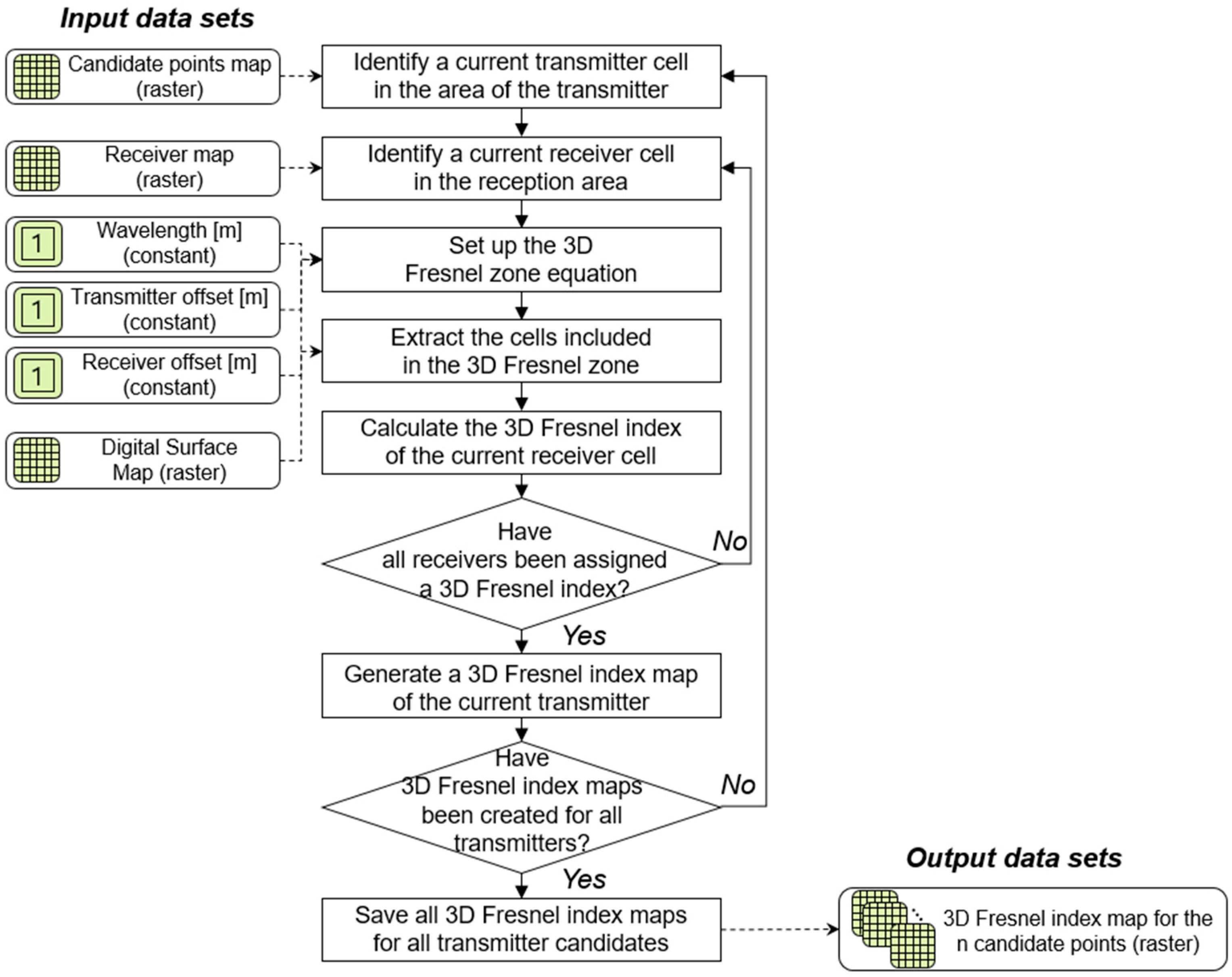
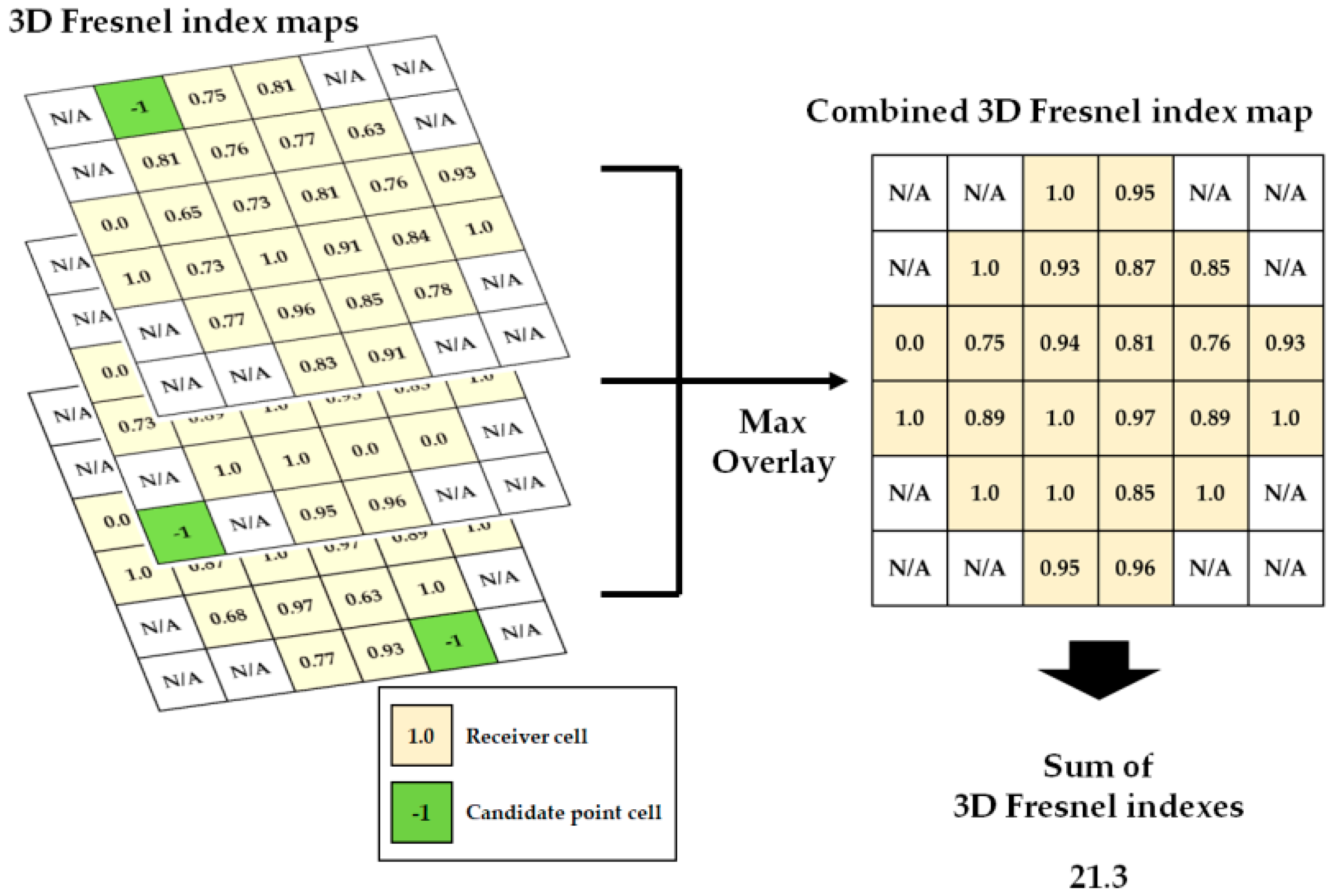
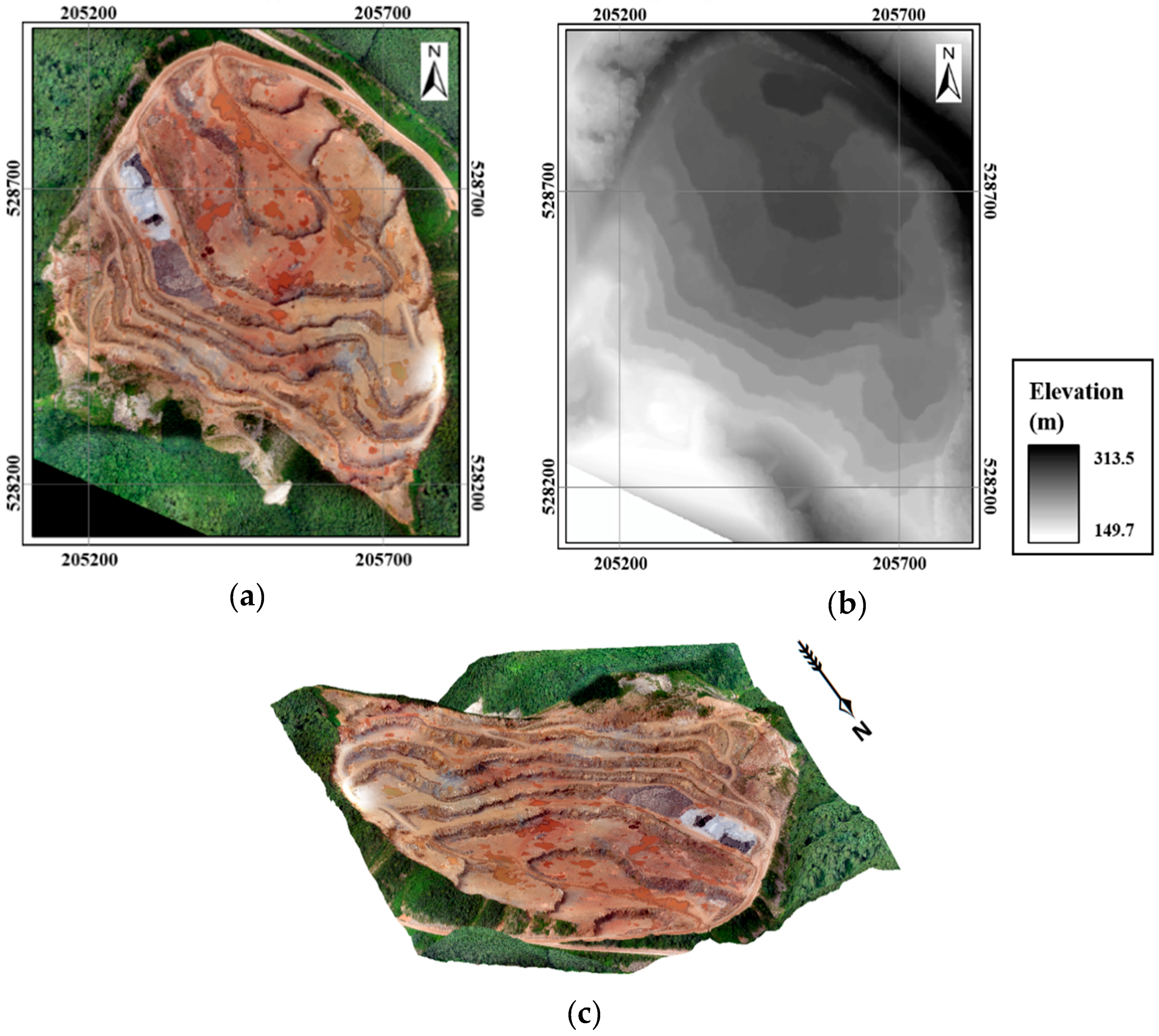
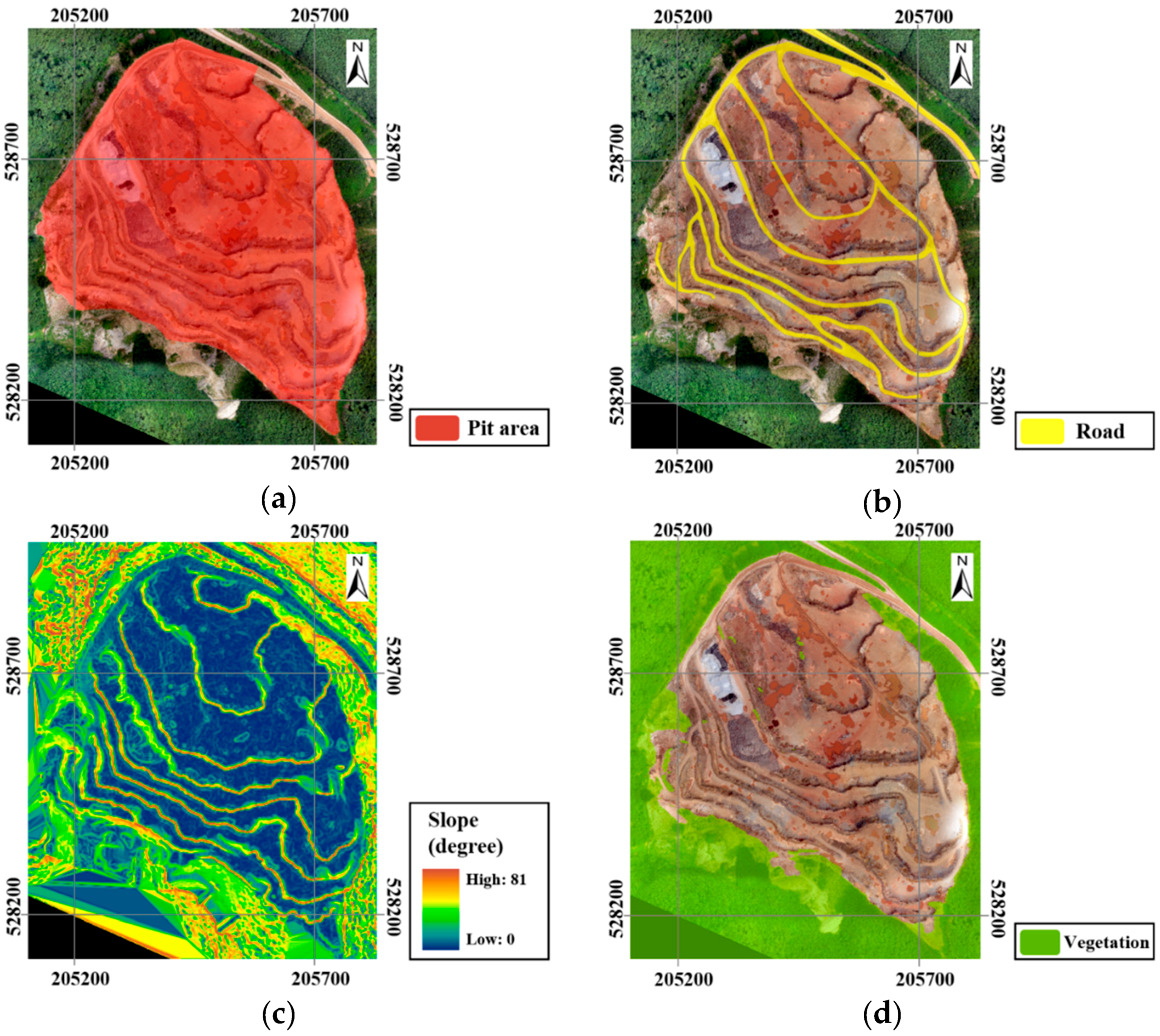
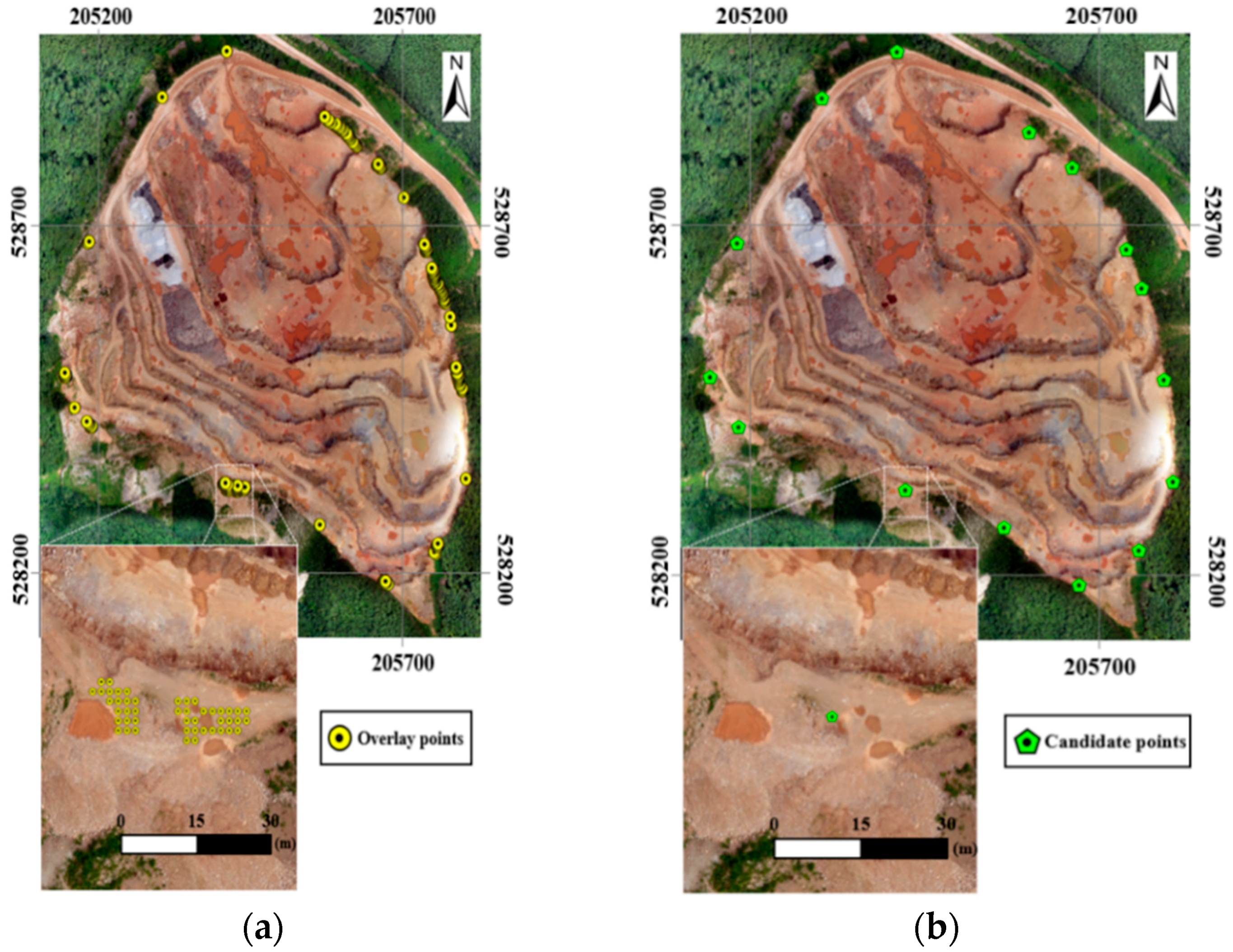
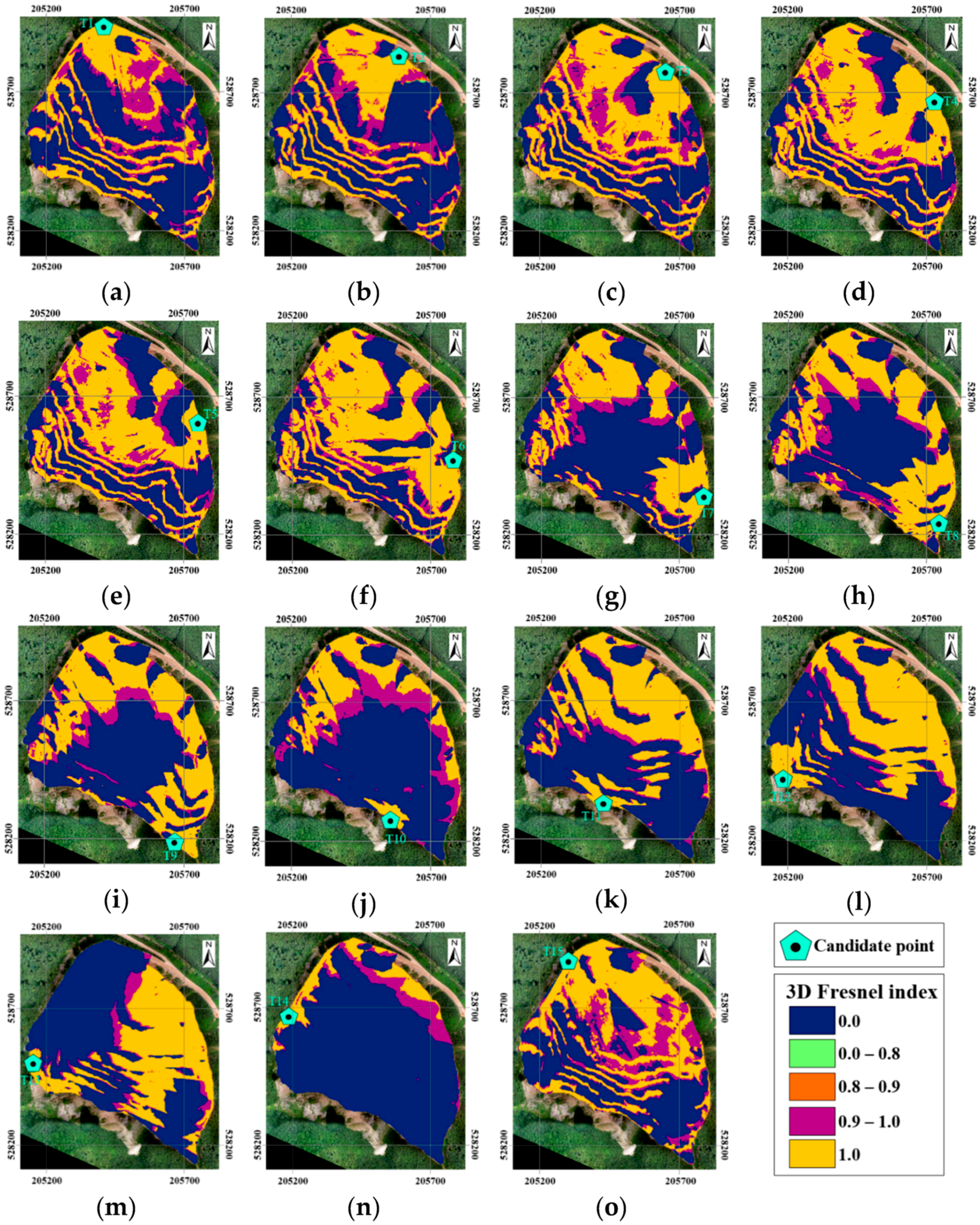


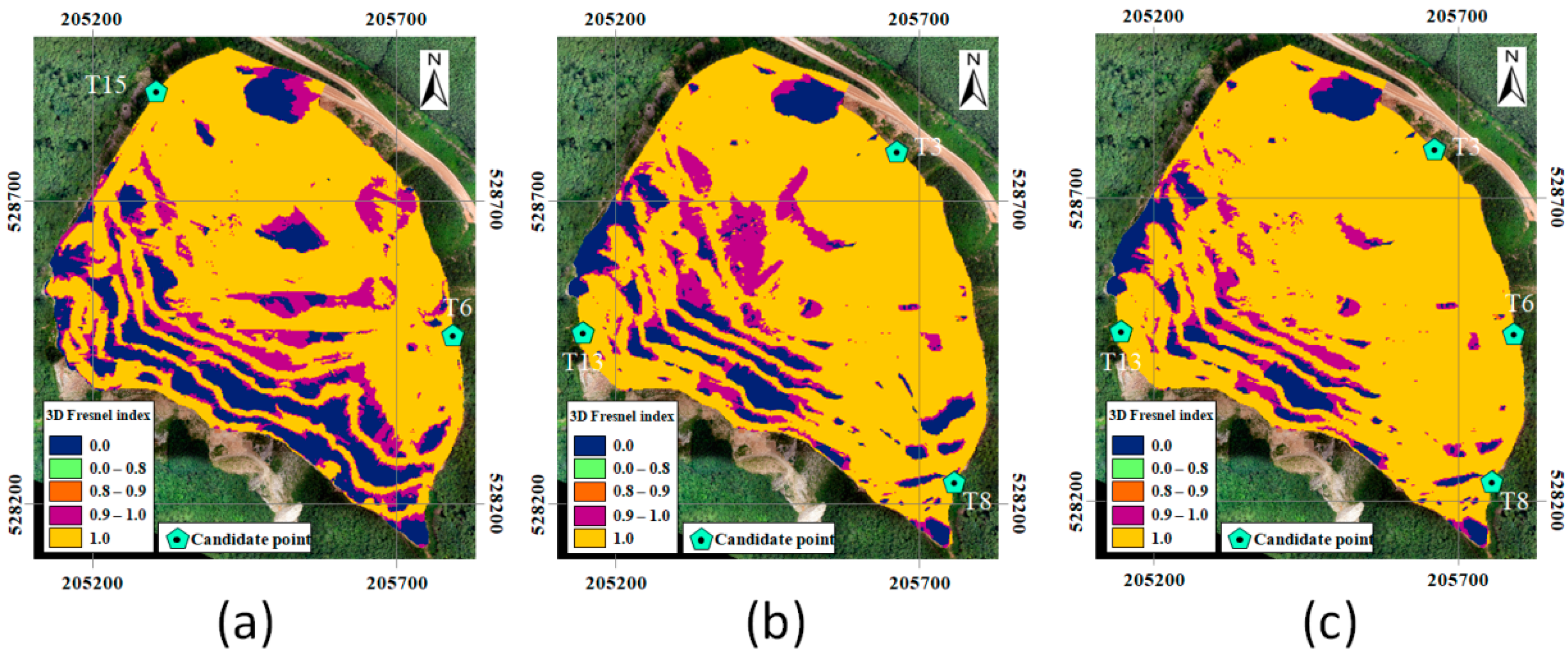



© 2018 by the authors. Licensee MDPI, Basel, Switzerland. This article is an open access article distributed under the terms and conditions of the Creative Commons Attribution (CC BY) license (http://creativecommons.org/licenses/by/4.0/).
Share and Cite
Baek, J.; Choi, Y. A New GIS-Based Algorithm to Support Initial Transmitter Layout Design in Open-Pit Mines. Energies 2018, 11, 3063. https://doi.org/10.3390/en11113063
Baek J, Choi Y. A New GIS-Based Algorithm to Support Initial Transmitter Layout Design in Open-Pit Mines. Energies. 2018; 11(11):3063. https://doi.org/10.3390/en11113063
Chicago/Turabian StyleBaek, Jieun, and Yosoon Choi. 2018. "A New GIS-Based Algorithm to Support Initial Transmitter Layout Design in Open-Pit Mines" Energies 11, no. 11: 3063. https://doi.org/10.3390/en11113063
APA StyleBaek, J., & Choi, Y. (2018). A New GIS-Based Algorithm to Support Initial Transmitter Layout Design in Open-Pit Mines. Energies, 11(11), 3063. https://doi.org/10.3390/en11113063





